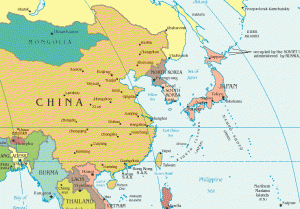 In Asia, America has gotta move away from a long-standing habit of engaging in simple, bilateral force measurements. Asia is a multi-polar place, and America’s penchant for strategic over-simplification is going to land the U.S. into serious trouble.
In Asia, America has gotta move away from a long-standing habit of engaging in simple, bilateral force measurements. Asia is a multi-polar place, and America’s penchant for strategic over-simplification is going to land the U.S. into serious trouble.
Put bluntly, U.S. Navy-folk need to remember there are a few other countries over on the other side of the Pacific. Some of them are rather formidable. And the U.S. is neglecting them.
So…Let’s take a moment to compare some naval forces in the Pacific Basin. Using the official DOD Annual Report to Congress on the Military Power of the PRC 2005 and 2009, it looks like China’s Navy is growing. But…when China’s rate of growth is compared with other neighbors, that burst of growth over the past five years looks a lot less daunting.
China: Diesel Attack Subs: (2005 vs. 2009): 51 vs. 54 (+3)
USA: Diesel Attack Subs: (2005 vs. 2009): 0 vs. 0 (+0)
Note: Japan commissioned 4 Oyashio-class, 2 Soryu-class SSKs; South Korea commissioned 3 Type 214s from 2005-2010.
China: Nuclear Subs (SSN only, 2005 vs. 2009): 6 vs. 6 (+0)
USA: Nuclear Subs (SSN/SSGN only 2005 vs. 2009): 58 vs. 56/57 (-2/
-1)
China: Destroyers (2005 vs. 2009): 21 vs. 27 (+7)
USA: Destroyers (2005 vs. 2009/10): 46 vs. 54/57 (+8/+11)
Note: Japan brought into service 2 Atago-class destroyers, 2 Takanami-class destroyers, and a Hyuga-class “carrier” destroyer; Taiwan put 4 ex-Kidd-class vessels into service; South Korea put 4 KDX-2-class destroyers into service over the past 5 years.
China: Frigates (2005 vs. 2009): 43 vs. 48 (+5)
USA: Frigates (2005 vs. 2009/10): 30 vs. 30/31 (+0/+1)
Note: Regional Frigate-building programs are proceeding apace.
China: Coastal Missile ships: (2005 vs. 2009): 51 vs 70+ (+19 at least)
USA: Nada. Zip.
Interesting. China’s small missile ships are allowing China’s larger vessels to engage in “blue water” activities, so, while these vessels expand China’s “reach”, a dependence on small ships may prove a vulnerability. The region needs to know more about the small ship programs hosted by Taiwan, South Korea and Japan. What, by way of smaller vessels, can these navies offer? How good are the region’s Air Forces in hunting and destroying smaller craft?
In short, does China’s love of small craft contribute to regional stability or not?
Look. China’s Navy is still awfully small. And with China not exactly on friendly terms with it’s neighbors (who, on the part of Japan and South Korea, are building some very modern navies), the PLA(N) has a lot to do to secure China’s maritime borders. It is a little bit of a stretch to think all this new floating hardware is aimed exclusively at the U.S.A.

{ 4 comments }
JMSDF can simply build more DDH-181 Heli Destoryer, currently only has 2 DDH, Load them up with F35 VTOL. With help from US carrier battle group, will ground the PLA.
Don’t forget to liberate us in Hong Kong, China Comu won’t even let us join the PLA to ensure we can’t infiltrate the PLA and have no access to weapon so they can crash us when we piss them off too much… China Comu has already started brain washing our kids with propaganda!
The Americans are just warmongers.
I say–Let the Japanese build carriers, more Aegis DDGs, and especially—let them buy the F-22. The Raptor will beat anything the PRC can put into the air. The Japanese Navy should be able to beat the PRC Navy, no problem, especially with our help. Also, to help the Japanese economy, allow Japan to market its weapons to other countries, especially their F-2.
Actually, South Korea also put into service their first KDX3 “Aegis”-destroyer plus an LHA, the “Dokdo”. Another two KDX3 plus another LHA are to follow. Their submarine program is to continue, creating a sizable force. In fact the triangle of China, South Korea and Japan is at least as significant for analysis as the bilateral relationship between the PLAN and the USN. Vietnam is about to establish a significant sub capability with Russian assistance, which makes China feel very uncomfortable, as far as the South China Sea is concerned. All of these procurements matter very much for the PLAN and influence their own efforts.
Comments on this entry are closed.